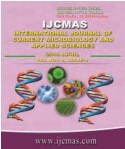


 National Academy of Agricultural Sciences (NAAS)
National Academy of Agricultural Sciences (NAAS)

|
PRINT ISSN : 2319-7692
Online ISSN : 2319-7706 Issues : 12 per year Publisher : Excellent Publishers Email : editorijcmas@gmail.com / submit@ijcmas.com Editor-in-chief: Dr.M.Prakash Index Copernicus ICV 2018: 95.39 NAAS RATING 2020: 5.38 |
A three years (2015-2017) study was carried out to study the diversity of Wood Rotting Fungi from two different forest stands, Hmuifang forest and Tanhril forest of Mizoram, Northeast India. A total of 45 species were identified from both the study sites. It was observed that a total of 21 species were common to both the forests whereas 19 species were found only found in Hmuifang forest and 5 species only in Tanhril forest. Shannon-Wiener’s diversity index of fungal species was found to be 3.31 in Hmuifang forest and 2.99 in Tanhril forest; Simpson shows 0.95 in Hmuifang and 0.90 Tanhril forest; Menhinick’s index shows 1.91 for Hmuifang and 1.22 in Tanhril forest; Margelef’s index shows 6.41 in Hmuifang and 3.98 in Tanhril forest; Pielou’s eveness index shows 0.54 in Hmuifang and 0.51 in Tanhril forest. However, the species diversity of wood rotting fungi was higher in Hmuifang forest than compared to Tanhril forest which may be due to higher altitude, low temperature, high relative humidity, soil moisture content and experiences higher amount of rainfall annually which in turn have a great impact on the type of vegetation.
 |
 |
 |
 |
 |